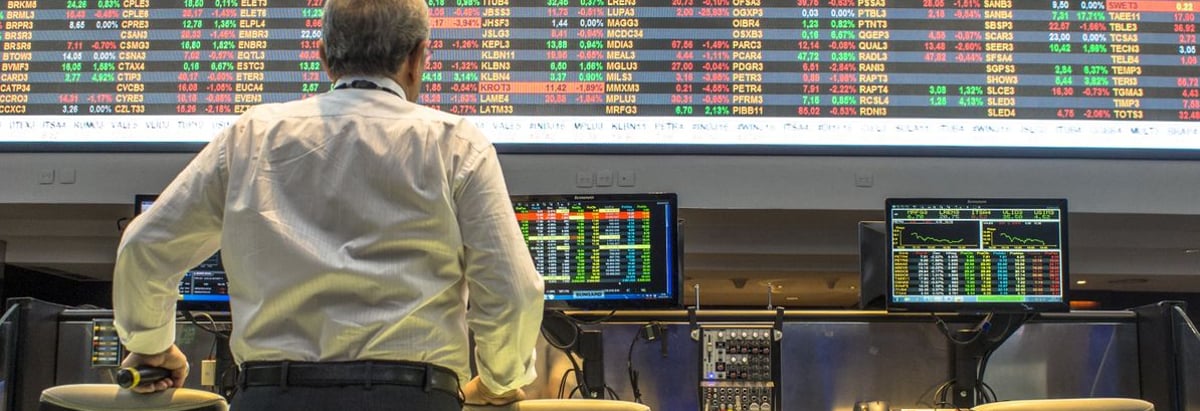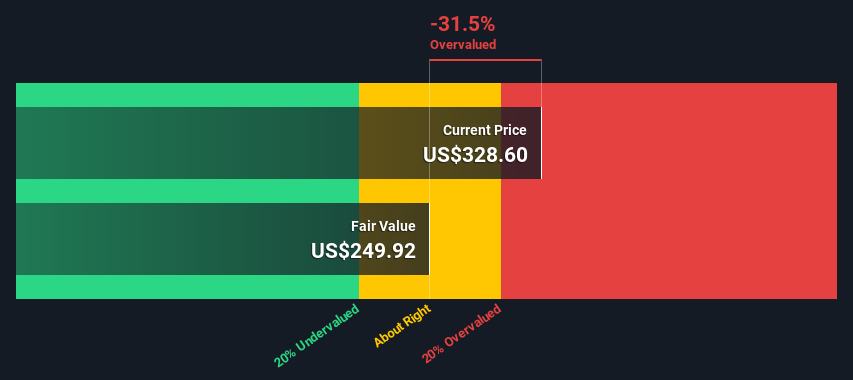- United States
- /
- Capital Markets
- /
- NasdaqGS:COIN
Estimating Coinbase's (NASDAQ:COIN) Intrinsic Value After Q3 Results

Coinbase Global, Inc. (NASDAQ: COIN) was one of the biggest winners in October, rising over 60% in the first half of the quarter. However, Q3 revenue didn't live up to the expectations, showing the ugly side of crypto volatility. As the stock pulls back, we will look at our valuation model based on the discounted cash flow (DCF).
View our latest analysis for Coinbase Global
Q3 Earnings Results
- GAAP EPS: US$1.62 (beat by US$0.19)
- Revenue: US$1.31b (miss by US$270m)
Highlights:
- This was the company's third straight quarter of revenue above US$1b
- Trading volume dropped 29% in comparison to Q2
- Bitcoin accounted for 19% of trading volume
- Retail trading volume was US$93b (36% drop from Q2)
- Institutional trading volume was US$234b (26% drop from Q2)
- Monthly Transacting Users (MTUs) – 7.4m (16% drop from Q2)
FY projections
- MTUs average 8m – 8.5m
- Average net transaction revenue per user per month – US$50
While crypto is a highly volatile market, one of the concerning numbers from the data above is that user activity is slowing down. This drop shows that there might be merit in criticism regarding Coinbase's fees.
In the aftermath, analysts are updating their forecasts and price targets with mixed results. Mizuho Securities rates Coinbase as Neutral, quoting a dramatic decline in retail take rate. They hold a price target of US$220.
On the other hand, some are more optimistic, like Wedbush (Outperform), Rosenblatt (Buy, PT of US$455), or JMP Securities (Outperform, PT of US$405).
Estimating the Intrinsic Value of Coinbase
According to our Discounted Cash Flow (DCF) model, we generally believe that a company's value is the present value of all cash it will generate in the future. However, a DCF is just one valuation metric among many, and it is not without flaws.
Anyone interested in learning a bit more about intrinsic value should have a read of the Simply Wall St analysis model.
The calculation
We use what is known as a 2-stage model, which means we have two different periods of growth rates for the company's cash flows. Generally, the first stage is higher growth, and the second stage is a lower growth phase.
First, we need to estimate the next ten years of cash flows. Where possible, we use analyst estimates, but when these aren't available, we extrapolate the previous free cash flow (FCF) from the last estimate or reported value. We assume companies with shrinking free cash flow will slow their rate of shrinkage and that companies with growing free cash flow will see their growth rate slow over this period. We do this to reflect that growth tends to slow more in the early years than in later years.
Generally, we assume that a dollar today is more valuable than a dollar in the future, so we need to discount the sum of these future cash flows to arrive at a present value estimate:
10-year free cash flow (FCF) estimate
| 2022 | 2023 | 2024 | 2025 | 2026 | 2027 | 2028 | 2029 | 2030 | 2031 | |
| Levered FCF ($, Millions) | US$1.93b | US$2.20b | US$1.57b | US$2.11b | US$2.12b | US$2.13b | US$2.16b | US$2.19b | US$2.22b | US$2.26b |
| Growth Rate Estimate Source | Analyst x5 | Analyst x5 | Analyst x2 | Analyst x2 | Est @ 0.32% | Est @ 0.81% | Est @ 1.16% | Est @ 1.4% | Est @ 1.57% | Est @ 1.68% |
| Present Value ($, Millions) Discounted @ 6.1% | US$1.8k | US$2.0k | US$1.3k | US$1.7k | US$1.6k | US$1.5k | US$1.4k | US$1.4k | US$1.3k | US$1.2k |
("Est" = FCF growth rate estimated by Simply Wall St)
Present Value of 10-year Cash Flow (PVCF) = US$15b
The second stage is also known as Terminal Value, and this is the business's cash flow after the first stage. For a number of reasons, a very conservative growth rate is used that cannot exceed that of a country's GDP growth. In this case, we have used the 5-year average of the 10-year government bond yield (2.0%) to estimate future growth. In the same way, as with the 10-year "growth" period, we discount future cash flows to today's value, using a cost of equity of 6.1%.
Terminal Value (TV)= FCF2031 × (1 + g) ÷ (r – g) = US$2.3b× (1 + 2.0%) ÷ (6.1%– 2.0%) = US$9.4m
Present Value of Terminal Value (PVTV)= TV / (1 + r)10= US$9.4m÷ ( 1 + 6.1%)10= US$226m
The total value, or equity value, is then the sum of the present value of the future cash flows, which in this case is US$250m. In the final step, we divide the equity value by the number of shares outstanding. Relative to the current share price of US$329, the company appears reasonably expensive at the time of writing.
The assumptions in any calculation significantly impact the valuation, so it is better to view this as a rough estimate, not precise down to the last cent.

The assumptions
The most important inputs to a discounted cash flow are the discount rate, and of course, the actual cash flows.The DCF also does not consider the possible cyclicality of an industry or a company's future capital requirements, so it does not give a complete picture of its potential performance.
Given that we are looking at Coinbase Global as potential shareholders, the cost of equity is used as the discount rate rather than the cost of capital (or the weighted average cost of capital, WACC), which accounts for debt. We've used 6.1% in this calculation, which is based on a levered beta of 0.950. Beta is a measure of a stock's volatility compared to the market as a whole. We get our beta from the industry average beta of globally comparable companies, with an imposed limit between 0.8 and 2.0, a reasonable range for a stable business.
Next Steps:
While many analysts remain optimistic, our valuation model shows that Coinbase might be slightly overvalued at this price. However, valuation is only one side of the coin in building your investment thesis. It shouldn't be the only metric you look at when researching a company - especially in the high growth, volatile sector like cryptocurrencies.
The DCF model is not a perfect stock valuation tool. Preferably you'd apply different cases and assumptions and see how they would impact the company's valuation. For instance, if the terminal value growth rate is adjusted slightly, it can dramatically alter the overall result.
What is the reason for the share price exceeding the intrinsic value? For Coinbase Global, we've put together three pertinent elements you should look at:
- Risks: We feel that you should assess the 2 warning signs for Coinbase Global (1 shouldn't be ignored!) we've flagged before investing in the company.
- Future Earnings: How does COIN's growth rate compare to its peers and the broader market? Dig deeper into the analyst consensus number for the upcoming years by interacting with our free analyst growth expectation chart.
- Other Solid Businesses: Low debt, high returns on equity, and good past performance are fundamental to a strong business. Why not explore our interactive list of stocks with solid business fundamentals to see if there are other companies you may not have considered!
PS. The Simply Wall St app conducts a discounted cash flow valuation for every stock on the NASDAQ every day. If you want to find the calculation for other stocks, just search here.
New: AI Stock Screener & Alerts
Our new AI Stock Screener scans the market every day to uncover opportunities.
• Dividend Powerhouses (3%+ Yield)
• Undervalued Small Caps with Insider Buying
• High growth Tech and AI Companies
Or build your own from over 50 metrics.
Have feedback on this article? Concerned about the content? Get in touch with us directly. Alternatively, email editorial-team@simplywallst.com
Simply Wall St analyst Stjepan Kalinic and Simply Wall St have no position in any of the companies mentioned. This article is general in nature. We provide commentary based on historical data and analyst forecasts only using an unbiased methodology and our articles are not intended to be financial advice. It does not constitute a recommendation to buy or sell any stock and does not take account of your objectives, or your financial situation. We aim to bring you long-term focused analysis driven by fundamental data. Note that our analysis may not factor in the latest price-sensitive company announcements or qualitative material.

Stjepan Kalinic
Stjepan is a writer and an analyst covering equity markets. As a former multi-asset analyst, he prefers to look beyond the surface and uncover ideas that might not be on retail investors' radar. You can find his research all over the internet, including Simply Wall St News, Yahoo Finance, Benzinga, Vincent, and Barron's.
About NasdaqGS:COIN
Coinbase Global
Operates platform for crypto assets in the United States and internationally.
Outstanding track record with excellent balance sheet.
Similar Companies
Market Insights
Community Narratives




